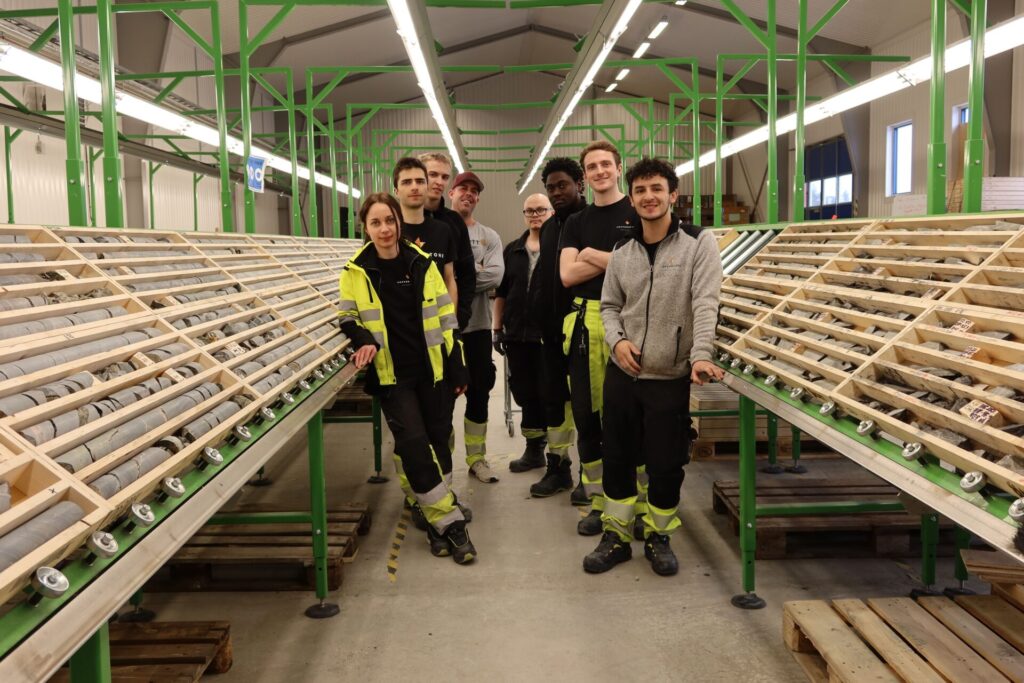Unlocking Viscaria
Geologists are the first people in a mining project to detect new copper findings in the rock. Here, Max and Elvis from Copperstone’s geology team talk about what it’s like to search for ore, and the excitement of finding a good drill core.
Some qualities are extra good to have as a geologist. Of course, you need the proper education, but it is also a plus if you are methodical and enjoy solving technical challenges in the field and at the office. Exploration is an integral part of a geologist’s work, although the search is rarely done at random.
─ Before we plan a drilling campaign, we always look at the existing geological data from the area. In the Viscaria project, we benefit from the fact that other companies have drilled a lot here earlier”, says Copperstone’s exploration geologist, Max Kröckert.
To test and prove the mineralization, drill cores are extracted from the ore body. They are samples that show the degree of mineralisation in the ore. Geologists also look for signs and vectors toward the copper mineralisation within the drill core. Such signs may be veins of carbonate or layers of magnetite, which have the potential to guide the drilling towards copper-rich areas. This work is essential because it lays the foundation for the mining project and the planned concentrating plant.
─ The rock and its mineralisation levels determine where the facilities should be established. The best feeling for a geologist in this project is to examine a fresh drill core with beautiful copper mineralisation”, says Nsioh Elvis Nkioh, Junior Geologist at Copperstone.

“The best feeling for a geologist in this project is to examine a fresh drill core with beautiful copper mineralisation”
The foundation for a safe mining environment
The geologists’ work lays the foundation for other parts of the project and is essential for building a safe mining environment. The team maps where the rock is strong and where there are faults, pockets or fragile parts. The information is then used by the mine planners, who determine the location of the tunnels and how they should be reinforced.
To date, geologists in the Viscaria project have logged copper mineralisations from the ground down to a depth of 1 kilometre. So far, they have not found where the mineralisation ends; the mineralisation is so called “open in all directions”
One kilometre below the surface
─ NQ-sized diamond drilling allows us to extract 5-centimetre-thick drill cores from 1km below the surface. These core samples are then placed on logging tables for evaluation by the geology team. Each drill core is a team effort from planning to sampling”, says Max.
From the core, it is possible to obtain a wealth of information about mineralisation styles, rock types, and, most importantly, metal content. Many geotechnical parameters are logged to determine rock strength and mechanical behaviour. These are essential to build mining infrastructure for a safe work environment. A good drill core is a treasure in the geologists’ ongoing work because it forms a map for safety planning and continued work.

Core drilling in Norrbotten
The geology team represents a variety of nationalities. One explanation for this is that geologists who want to work in large mining projects must be prepared to travel to where the ore is located and move on to the next job when the mining project ends. Thus, Viscaria’s geology team has a great deal of combined experience from different work environments and notes that Norrbotten has unique characteristics as a place of work.
─ Here, we have to adapt the work to the changing seasons. The winter allows us to access areas that are otherwise too soft and wet to place a drill rig, so we drill in different areas between summer and winter. The wetlands during the summer come with their own challenges and mosquitos during fieldwork. On the other hand, Viscaria’s proximity to Kiruna and adjacent infrastructure is an advantage. People who live in Malmfälten have a great acceptance and knowledge of mining operations, which is very positive. Those conditions are rarely found in other mining projects, Max concludes.
Facts
Viscaria’s copper ore has a concentration of between 0.4 and 2 per cent, with an average of approx. 1.2 percent. This places the degree of mineralisation of the Viscaria mine at a relatively high level in a global comparison to other copper projects, twice the grade of the global average.
The infill drill holes (defining an already encountered orebody) go down to a depth of 500 metres. Exploration drill holes can be extended to 1,000 metres below ground.
Viscaria’s A and B-Zones extend over an area of 4 kilometres. The D-Zone mineralization extends over a distance of 1.5 kilometres, but there is a 7 km magnetic anomaly in the area, so the D-zone may grow further.